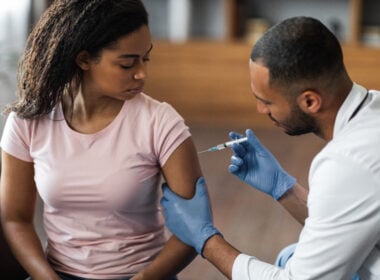I woke abruptly that midwinter morning, with my body beginning to shake and heat rising to my face. As I pulled back the covers, I tied up my hair and then began peeling off layers of clothing. I knew what was coming. For the next hour, I lay on the floor of our tiny bathroom, grateful for its coolness. My face was whiter than the hex-pattern tile beneath it, and I alternated between taking deep breaths and hurrying to the toilet. Gripped by nausea, I could feel spasms deep within me, as though my body had to work overtime to expel the dark red clots into the water below.
Women experiencing menopausal hot flashes might recognize some of these symptoms. But here I was, a seemingly healthy 25-year-old unable to do anything but pray for patience and try to keep down two Motrin. An hour later, the symptoms disappeared as quickly as they had come, and I was left with only a dull ache in my head and my uterus.
Always the same refrain: “If you don’t want to go on birth control, there’s nothing I can do for you.”
Later that month, I told a nurse practitioner about my symptoms, and she commiserated. “It’s normal to experience heavy periods some months,” she said. “Would you like to try birth control?” When I declined, she sent me on my way.
In fairness to my nurse practitioner, it’s entirely possible I downplayed my own symptoms at that appointment. Having lived in three different cities during my college and graduate school years, I had seen my fair share of medical professionals when dutifully attending yearly physicals and OB-GYN wellness checks. I told each of them about my other symptoms—irregular periods, debilitating migraines, and these occasional, intense hot flashes—and they all said the same thing: If I didn’t want to go on birth control, there wasn’t much they could offer as a solution.
Hormone imbalance hijinks
I had done enough research on the ways birth control masks cycle irregularities and comes with a host of side effects to decide that it wasn’t an option for me. Instead, I continued through graduate school and got married, getting a sumatriptan prescription for my migraines and tracking my cycles using the Clearblue Fertility Monitor. For many women with more regular cycles, this can be a useful tool to detect their estrogen rise and LH surge each month. For me, the information it provided was baffling.
Most months, the monitor would detect an estrogen surge that went on for days, but the LH surge never came. Weeks of breakthrough bleeding would follow. Occasionally I’d have a more “normal” cycle and I would brush all my concerns aside, hoping that things had somehow gotten back on track.
Deciding that I deserved better than painful, irregular periods
It wasn’t until I’d been married for two years and my husband and I wanted to start a family that I began to seriously consider learning the Creighton Model, a fertility awareness method (FAM) based on cervical mucus observations. A good friend had been using Creighton for years, and she reminded me that its ties to NaProTechnology (Natural Procreative Technology) make it a compelling option for those with hormonal imbalances that might require medical intervention. She also reminded me that healing the body naturally takes time, and that I deserved to begin that journey today.
The breaking point came when I went to see another OB-GYN and told her that my husband and I had been trying to conceive over the last few months—or would have been if I’d had any signs of ovulation during this time. Her advice was similar to what I’d received in the past, but she did have one new suggestion for me. She told me not to track my cycle, because this would only cause stress. She also told me to come back in a year if we still hadn’t conceived, and that at that point we could talk with an infertility specialist.
For a couple of weeks, I listened and was even comforted by her advice to “wait and see.” Perhaps I was overreacting, I thought, and my symptoms would resolve on their own. But when the gap between my last period and the present widened to nearly three months, I decided I’d had enough.
Finding healing for my irregular periods through fertility awareness, and—finally—a diagnosis
This past October, I began learning how to track my cycle using the Creighton Model through zoom sessions with a fertility awareness practitioner at Revive FertilityCare. In the beginning, the process felt slow. I’d waited to seek help until I’d already been dreaming of a baby for months, and so every week of more waiting felt like a month, and every month, a year. Now, I look back on my Creighton journey and marvel at all that has unfolded within six months. Within three months, I learned that I have a continuous mucus pattern indicative of estrogen dominance and inflammation. My chart also confirmed that I wasn’t ovulating regularly, making conception impossible. Within four months, my chart, lab tests, and an ultrasound yielded a diagnosis of insulin resistance and adrenal-driven PCOS.
Why Polycystic Ovary Syndrome (PCOS) can make it difficult to get pregnant
PCOS, or polycystic ovary syndrome, is characterized by a hormonal imbalance that leads to symptoms including irregular periods, acne, and excessive hair growth or hair loss. In women with PCOS, the ovaries or adrenal glands produce high levels of androgens, which are a class of hormones characterized as “male.” These high androgen levels hinder ovulation by preventing the maturation of an egg each month, and these undeveloped follicles may accumulate over time and form “cysts.” In some (but not all) women with PCOS, an ultrasound may help diagnose the condition by showing ovaries that contain an abnormal number of these undeveloped follicles. Research suggests that 5 to 15% of women of reproductive age suffer from PCOS, and that it is the leading cause of anovulatory infertility.
Getting treatment for PCOS
Scientists now believe that PCOS is tied closely to insulin resistance, and my family’s history of type 2 diabetes pre-disposes me to this problem. Determined to tackle my insulin resistance and inflammation, in January I committed to the AIP (autoimmune protocol) diet for a month and reintroduced foods to determine which ones cause a negative reaction. In order to manage my PCOS, I now do my best to eat a diet free of gluten, dairy, and processed sugar year-round.
Through a combination of this anti-inflammatory diet, targeted supplements including myo-inositol, and low-dose medication to combat my adrenal issues, I tracked a 35-day cycle within six months, and I am on track to see a 30-day cycle this month; remarkable numbers for someone whose irregular periods were once the rule, rather than the exception. It’s not yet the healthy pregnancy I’ve prayed for, but it is progress that gives me hope. I no longer have to “wait and see” what will happen to my body each month. Instead, I can be proactive in tracking my hormones and making adjustments through supplements, medication, and stress management.
Don’t wait to get help for painful or irregular periods —even if you’re not trying to get pregnant
I’m still in the thick of my journey to regulate my cycles and manage my PCOS, but I am amazed by how far I’ve come. I am grateful for a system of fertility care designed to address the root causes of my symptoms rather than mask them. I’m grateful, too, for a caring fertility awareness practitioner who has empowered me to take control of my health. In addition to teaching my husband and me this method of tracking my cycle naturally, my practitioner listened to my story in a way most doctors simply haven’t taken the time to. She has supported me through each step of this process, from offering encouragement during my month on the autoimmune protocol to connecting me with an OB-GYN who knows how to read my chart and order lab tests based on the information it offers.
I want you to know that, if you’ve seen a dozen doctors who discounted your symptoms, you deserve to work with a fertility awareness instructor who won’t. You can learn about the fertility awareness methods available to you and find an instructor who can help you learn it here. If you’ve been living with symptoms like painful, irregular periods, or other mysterious symptoms suggesting hormone imbalance, I urge you not to wait to seek help. Today could be the first step of your journey to find healing.
Additional Reading
When it Comes to Irregular Periods, Fertility Charting Works Better Than Birth Control
Insulin Resistance, PCOS, and Fertility Health: Are you at risk?
How Charting My Cycles with Fertility Awareness Saved My Life
“Isn’t NaProTechnology Just Charting?” and other questions: A Natural Womanhood NaPro FAQ
Natural solutions for heavy periods
Medical Benefits of Fertility Awareness: Why Doctors Should Embrace the Science of Charting











